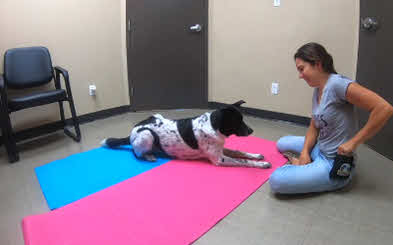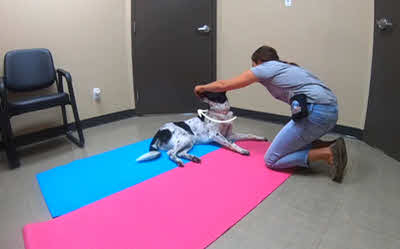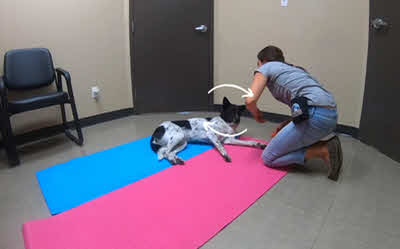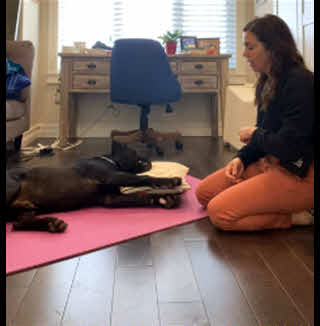Training consent behaviors builds confidence, promotes force-free learning, and increases your pet’s cooperation. When your dog offers a consent behavior they are giving permission for something to happen. It is the “green light” that communicates your dog is ready to participate in a procedure. If they move out of position, it is the “red light” to stop.
Lateral recumbency is the positioning of an animal on their side with their head on the ground. In this position, it is easy to see and access the paws for nail trims. Your dog can be taught this position as a consent behavior, and it may be done on a mat on the ground or an elevated surface such as a couch. Your dog shows willingness to cooperate for a nail trim by moving into this position. Lifting their head off the ground is an indication to stop the procedure. Continue paw handling and nail trims when they place their head back down.
Choose a mat or other comfortable surface to teach this behavior. Lure your dog into a down position, mark and treat:
Photo Courtesy of Jessica Benoit RVT, VTS (Behavior), KPA CTP, CPDT-KA, EFFCP

Photo Courtesy of Jessica Benoit RVT, VTS (Behavior), KPA CTP, CPDT-KA, EFFCP
Hold a treat near your dog’s nose and move the treat from their nose toward their shoulder, then mark and treat once they shift onto their hip into a relaxed down position:
Photo Courtesy of Jessica Benoit RVT, VTS (Behavior), KPA CTP, CPDT-KA, EFFCP

Photo Courtesy of Jessica Benoit RVT, VTS (Behavior), KPA CTP, CPDT-KA, EFFCP
Hold a treat near your dog’s nose and move it slowly toward their ribs/mid-spine area. Your dog should shift onto their shoulder. Then mark and treat:
Photo Courtesy of Jessica Benoit RVT, VTS (Behavior), KPA CTP, CPDT-KA, EFFCP

Photo Courtesy of Jessica Benoit RVT, VTS (Behavior), KPA CTP, CPDT-KA, EFFCP
Hold a treat near your dog’s nose and move it in a circle from their nose, over the shoulder, and up and over the back area then back to the nose. Your dog should move onto their shoulder and place their head onto the ground. Mark and treat:
Photo Courtesy of Jessica Benoit RVT, VTS (Behavior), KPA CTP, CPDT-KA, EFFCP

Photo Courtesy of Jessica Benoit RVT, VTS (Behavior), KPA CTP, CPDT-KA, EFFCP
Dogs may have difficulty moving downward from elbow to shoulder. Placing a pillow behind the shoulder closest to the ground helps minimize the distance between your dog’s head and the ground and may be more comfortable for them:
Photo Courtesy of Jessica Benoit RVT, VTS (Behavior), KPA CTP, CPDT-KA, EFFCP

Photo Courtesy of Jessica Benoit RVT, VTS (Behavior), KPA CTP, CPDT-KA, EFFCP
Go at your dog’s pace. Dogs may spend multiple sessions working on the same step before progressing.
Since the mat, the nail trimmers, and position of your body become contextual cues, verbal cues may not be used for lateral positioning. When your dog offers the position at least 80 percent of the time in one session, then paw handling and nail trims can be trained using this consent behavior.